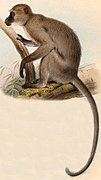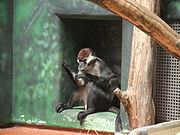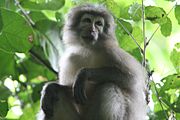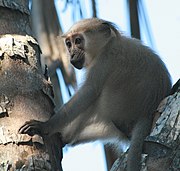White-eyelid mangabey
Appearance
(Redirected from Cercocebus)
| White-eyelid mangabeys | |
|---|---|

| |
| Sooty mangabey (Cercocebus atys) | |
| Scientific classification | |
| Domain: | Eukaryota |
| Kingdom: | Animalia |
| Phylum: | Chordata |
| Class: | Mammalia |
| Order: | Primates |
| Suborder: | Haplorhini |
| Infraorder: | Simiiformes |
| Family: | Cercopithecidae |
| Subfamily: | Cercopithecinae |
| Tribe: | Papionini |
| Genus: | Cercocebus É. Geoffroy, 1812[1] |
| Type species | |
| Cercocebus fuliginosus | |
| Species | |
|
See text | |
| Synonyms[1] | |
| |
The white-eyelid mangabeys are African Old World monkeys belonging to the genus Cercocebus. They are characterized by their bare upper eyelids, which are lighter than their facial skin colouring, and the uniformly coloured hairs of the fur.[2] The other two genera of mangabeys, Lophocebus and Rungwecebus, were once thought to be very closely related to Cercocebus, so much so that all the species were placed in one genus, but Lophocebus and Rungwecebus species are now understood to be more closely related to the baboons in genus Papio, while the Cercocebus species are more closely related to the mandrill.
Species
[edit]| Common name | Scientific name and subspecies | Range | Size and ecology | IUCN status and estimated population |
|---|---|---|---|---|
| Agile mangabey | C. agilis A. Milne-Edwards, 1886 |
Central Africa
|
Size: 44–65 cm (17–26 in) long, plus 45–79 cm (18–31 in) tail[3] Habitat: Forest[4] Diet: Fruit, seeds and shoots, as well as small vertebrates[4] |
LC
|
| Collared mangabey | C. torquatus (Kerr, 1792) |
Western Africa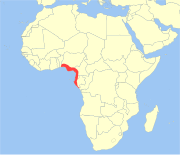
|
Size: 45–67 cm (18–26 in) long, plus 60–75 cm (24–30 in) tail[5] Habitat: Forest[6] Diet: Fruit and nuts, as well as stems and roots[5] |
EN
|
| Golden-bellied mangabey | C. chrysogaster Lydekker, 1900 |
Central Africa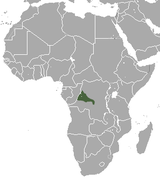
|
Size: 40–80 cm (16–31 in) long, plus 45–100 cm (18–39 in) tail[7] Habitat: Forest[8] Diet: Invertebrates, fruit, seeds, and nectar[7] |
EN
|
| Sanje mangabey | C. sanjei Mittermeier, 1986 |
East-central Africa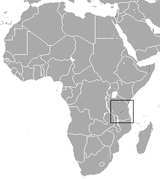
|
Size: 50–65 cm (20–26 in) long, plus 55–65 cm (22–26 in) tail[9] Habitat: Forest[10] Diet: Fruit, nuts, and seeds, as well as fungi, invertebrates, and plants[10] |
EN
|
| Sooty mangabey | C. atys (Audebert, 1797) |
Western Africa | Size: 40–68 cm (16–27 in) long, plus 40–80 cm (16–31 in) tail[11] Habitat: Forest and savanna[12] Diet: Fruit and nuts, as well as swamp plants, grass, seeds, fungi, and invertebrates[11] |
VU
|
| Tana River mangabey | C. galeritus Peters, 1879 |
Eastern Africa
|
Size: 44–63 cm (17–25 in) long, plus 50–68 cm (20–27 in) tail[13] Habitat: Forest, shrubland, and inland wetlands[14] Diet: Fruit and seeds, as well as stems, leaves, insects, and fungi[13] |
CR
|
| White-naped mangabey | C. lunulatus (Temminck, 1853) |
Western Africa
|
Size: 52–73 cm (20–29 in) long, plus 68–74 cm (27–29 in) tail[5] Habitat: Forest and inland wetlands[15] Diet: Fruit, leaves, seeds, buds, and grass[16] |
EN
|
References
[edit]- ^ a b c Groves, C. P. (2005). Wilson, D. E.; Reeder, D. M. (eds.). Mammal Species of the World: A Taxonomic and Geographic Reference (3rd ed.). Baltimore: Johns Hopkins University Press. pp. 153–154. ISBN 0-801-88221-4. OCLC 62265494.
- ^ Chisholm, Hugh, ed. (1911). . Encyclopædia Britannica. Vol. 17 (11th ed.). Cambridge University Press. p. 568.
- ^ Kingdon 2015, p. 136
- ^ a b c Maisels, F.; Hicks, T. C.; Hart, J.; Shah, N. (2020) [amended version of 2019 assessment]. "Cercocebus agilis". IUCN Red List of Threatened Species. 2020: e.T136615A167735266. doi:10.2305/IUCN.UK.2020-1.RLTS.T136615A167735266.en.
- ^ a b c Kingdon 2015, p. 134
- ^ a b Maisels, F.; Oates, J. F.; Linder, J.; Ikemeh, R.; Imong, I.; Etiendem, D. (2019) [errata version of 2019 assessment]. "Cercocebus torquatus". IUCN Red List of Threatened Species. 2019: e.T4201A154210757. doi:10.2305/IUCN.UK.2019-1.RLTS.T4201A154210757.en.
- ^ a b Patterson, Haley (2017). "Cercocebus chrysogaster". Animal Diversity Web. University of Michigan. Archived from the original on August 12, 2023. Retrieved July 24, 2023.
- ^ a b Hart, J. A.; Thompson, J. (2020). "Cercocebus chrysogaster". IUCN Red List of Threatened Species. 2020: e.T4207A17956177. doi:10.2305/IUCN.UK.2020-2.RLTS.T4207A17956177.en.
- ^ Kingdon 2015, p. 137
- ^ a b c McCabe, G; Rovero, F.; Fernández, D.; Butynski, T. M.; Struhsaker, T. T. (2019). "Cercocebus sanjei". IUCN Red List of Threatened Species. 2019: e.T4203A17955753. doi:10.2305/IUCN.UK.2019-3.RLTS.T4203A17955753.en.
- ^ a b Lee, Scarlett (2012). "Cercocebus atys". Animal Diversity Web. University of Michigan. Archived from the original on July 24, 2023. Retrieved July 24, 2023.
- ^ a b Koné, I.; McGraw, S.; Gonedelé Bi, S.; Barrie, A. (2020). "Cercocebus atys". IUCN Red List of Threatened Species. 2020: e.T136933A92248451. doi:10.2305/IUCN.UK.2020-2.RLTS.T136933A92248451.en.
- ^ a b Mittl, Gregory (2011). "Cercocebus galeritus". Animal Diversity Web. University of Michigan. Archived from the original on August 12, 2023. Retrieved July 24, 2023.
- ^ a b Butynski, T. M.; de Jong, Y. A.; Wieczkowski, J.; King, J. (2020). "Cercocebus galeritus". IUCN Red List of Threatened Species. 2020: e.T4200A17956330. doi:10.2305/IUCN.UK.2020-2.RLTS.T4200A17956330.en.
- ^ a b Dempsey, A.; Gonedelé Bi, S.; Matsuda Goodwin, R.; Koffi, A. (2020). "Cercocebus lunulatus". IUCN Red List of Threatened Species. 2020: e.T4206A92247733. doi:10.2305/IUCN.UK.2020-2.RLTS.T4206A92247733.en.
- ^ Kingdon 2014, p. 184
Sources
[edit]- Kingdon, Jonathan (2014). Mammals of Africa. Vol. II: Primates. A & C Black. ISBN 978-1-4081-8991-7.
- Kingdon, Jonathan (2015). The Kingdon Field Guide to African Mammals (Second ed.). Bloomsbury Publishing. ISBN 978-1-4729-2531-2.
External links
[edit]Wikimedia Commons has media related to Cercocebus.
Wikispecies has information related to Cercocebus.

